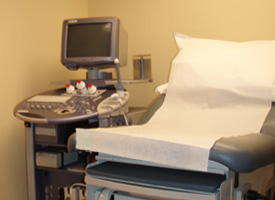
Know your options to determine which genetic screening test may be best for you
FEBRUARY 6, 2010--LANSDOWNE, VIRGINIA
Genetic screening for chromosomal and other anomalies has advanced tremendously recently. The best screening method we had to offer pregnant women was the second trimester screening, a blood test that is mired with issues.
The second trimester screening is a blood test offered to many women over the years to screen their fetus during their 15th to 20th week of pregnancy. This test has been quoted to achieve "high" detection rates for Down's syndrome and Trisomy 18 and spina bifida or other spinal defects. The problem with the second trimester testing is that it is not diagnostic, and also has a high false-positive rate; meaning a positive test occurs in 5% of cases, but does not necessarily mean that the fetus is affected by a genetic illness. After a positive test, many women choose to have a diagnostic amniocentesis. However, an amniocentesis carries risk and can lead to a miscarriage.
Recently, the nuchal translucency and blood screening test was developed to screen women between 10-12 weeks of gestation. This test allows for the detection of limited trisomy affected fetuses in an earlier stage of development thus allowing more time to prepare and educate pregnant women affected by the results. This test was developed by performing a nuchal translucency (looking at the thickness of the back of the fetus) with ultrasound and taking three drops of blood from a finger prick to analyze the data and obtain a risk of having the trisomy. The limitation of this test is that the spinal defect risk is not obtained during this test, so a second trimester blood screen still has to be performed for that analysis to occur.
Improvements to decrease the high false-positive rates of tests while keeping them less invasive have been on the forefront of research. Recently, sequential and integrated screening have been developed. These tests combine results from the first and second trimester screening to achieve higher detection rates of anomalies and have been gaining more support in the last couple of years.
Ultrasound testing in the second trimester between 18-20 weeks has been used for many years now to screening of fetal anomalies and to detect chromosomal problems. The testing is non-invasive; however, it provides relatively low detection rates and should not be used as a diagnostic test.
The definitive diagnostic test has always been an amniocentesis or chorionic villus sampling (CVS). Both these tests are invasive and may lead to loss of pregnancy; therefore, most women are not inclined to choose this route because of these risks. However, women and partners at high risk for genetic illness may use this test as a diagnostic test for fetal genetic illness. These tests were previously only offered to women who are pregnant that will be over 35 years old at time of delivery or at a higher risk for having a baby with a for genetic illness. Now the recommendations have changed and include offering these invasive tests to all women who are pregnant.
Of course, all this talk about genetic screening does not take into account that some women opt out of genetic screening altogether due to personal or religious reasons. You have the right to decline any or all of this testing but being well-informed about your options will help you make the best decision. Make sure your obstetrician reviews your options during your pregnancy and you discuss your wishes for genetic screening during your pregnancy.